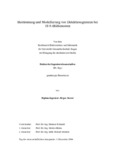Citation link:
https://nbn-resolving.org/urn:nbn:de:hbz:467-950| DC Field | Value | Language |
|---|---|---|
| dc.contributor.author | Sterzel, Jürgen | - |
| dc.date.accessioned | 2019-09-02T09:54:16Z | - |
| dc.date.available | 2005-10-6T12:12:12Z | - |
| dc.date.available | 2019-09-02T09:54:16Z | - |
| dc.date.issued | 2005 | - |
| dc.description.abstract | Thin-Film-on-ASIC- (TFA-) Sensoren nutzen als fotoelektrischen Wandler eine Dünnschicht auf Basis amorphen Siliziums, die großflächig über das 2-dimensionale kristalline Pixelarray aufgebracht ist. In der Arbeit werden von integrierenden TFA-Bildsensoren die Grenzeigenschaften Empfindlichkeit, Dunkelstrom, temporäres und örtliches Rauschen untersucht. Eine gute Stromempfindlichkeit wird durch optimale Detektorgeometrien erreicht. Parasitäre Kapazitäten der 3-dimensionalen Anordnung und die gewählte Pixeleingangsschaltung bestimmen die Wandlungs- oder Spannungsempfindlichkeit. Dunkelstromanteile sind durch thermische Effekte bzw. durch Feldeffekte bestimmt. Der Sperrstrom des Detektors, der Leckstrom des Resettransistors und der Leckstrom über das Treibergate sind zu bewerten. Je nach dominierendem Anteil ändert sich die Temperaturabhängigkeit. Bei ohmschen Anteilen ist die Dunkelstromverbesserung durch Kühlung vernachlässigbar. Die Einbindung des Detektorrauschens von Foto- und Dunkelstrom in SPICE ermöglicht die Bestimmung des Signal-Rauschabstands und des Dynamikbereichs der Pixeleingangsstufe. Bei der Detektionsschwelle dominiert i. d. R. das Treiberrauschen. Eine Beschreibung für das Verstärkungs-FPN (PRNU) ist mithilfe der Momentenmethode dargestellt. Das temporäre Rauschen geht stärker in die Pixeleingangsstufe ein als das örtliche Rauschen. Durch die allgemein gültige Beschreibung sind die zentralen Ergebnisse dieser Arbeit für CMOS- als auch für TFA-Bildsensoren anwendbar. | de |
| dc.description.abstract | Thin-Film-on-ASIC (TFA) sensors use a thin film layer as photoelectric detector. Based on amorphous silicon, the film is deposited on top of the 2-dimensional crystalline pixel area. This thesis analyses the limiting properties of integrating TFA image sensors, i.e. sensitivity, dark current, temporal and fixed pattern noise. A useful current sensitivity is obtained with optimized detector geometries. Parasitic capacitances of the 3-dimensional design and the selected pixel input circuit determine the conversion or voltage sensitivity. The dark current is determined by thermal effects or electrical field effects. The reverse current of the detector, the leakage current of the reset transistor and the leakage current of the driver gate have to be considered. The dark current temperature dependence varies with the dominating physical property. Dark current improvements of ohmic components by cooling are negligible. The integration of photo and dark current detector noise into SPICE enables the determination of the signal-to-noise ratio and the dynamic range of the pixel input stage. In most cases, the driver transistor noise determines the detection limit. A description of gain FPN (PRNU) depending on the transistor geometry is developed using the moment method. Temporal noise has a stronger influence on the pixel input stage than fixed pattern noise. Due to the generally valid description, the central results of this thesis are applicable to normal CMOS as well as TFA image sensors. | en |
| dc.identifier.uri | https://dspace.ub.uni-siegen.de/handle/ubsi/95 | - |
| dc.identifier.urn | urn:nbn:de:hbz:467-950 | - |
| dc.language.iso | de | de |
| dc.rights.uri | https://dspace.ub.uni-siegen.de/static/license.txt | de |
| dc.subject.ddc | 620 Ingenieurwissenschaften und Maschinenbau | de |
| dc.subject.other | TFA-technology | en |
| dc.subject.other | Image sensors | en |
| dc.subject.other | Fixed-pattern-noise | en |
| dc.title | Bestimmung und Modellierung von Detektionsgrenzen bei TFA-Bildsensoren | de |
| dc.type | Doctoral Thesis | de |
| item.fulltext | With Fulltext | - |
| ubsi.date.accepted | 2004-12-02 | - |
| ubsi.publication.affiliation | Fachbereich 12, Elektrotechnik und Informatik | de |
| ubsi.subject.ghbs | WFCD | - |
| ubsi.type.version | publishedVersion | de |
| Appears in Collections: | Hochschulschriften | |
Files in This Item:
| File | Description | Size | Format | |
|---|---|---|---|---|
| sterzel.pdf | 2.4 MB | Adobe PDF |  View/Open |
This item is protected by original copyright |
Page view(s)
353
checked on Apr 3, 2025
Download(s)
378
checked on Apr 3, 2025
Google ScholarTM
Check
Items in DSpace are protected by copyright, with all rights reserved, unless otherwise indicated.

